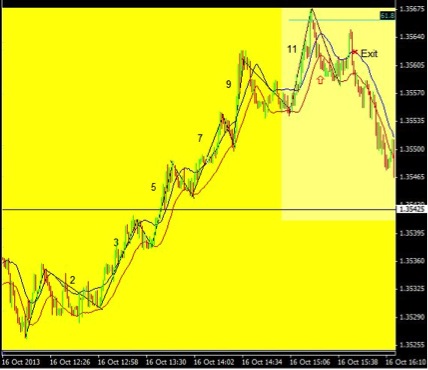How to Read the EUR/USD – October 16 EUR/USD Day Trades
Paying attention to price action doesn’t just occur before a trade, price action is also very closely monitored while a trade is underway.
We take trades because our strategy indicates to do so based on current market conditions, and a stop loss and profit target are placed to limit risk as well as capitalize on those conditions. But conditions change.
Managing Trades
When starting out it is beneficial to let the price hit either your stop or profit target. This forces you to become detached emotionally from the trade, let the market move without trying to impose your will on it, as well as fine-tune your strategy. Once discipline has been developed, as well as a heightened ability to read the market, there is no reason to let your stop get hit if you see that conditions have turned against you.
One of my trades today provided an example of this.
Figure 1. EUR/USD Failed Trade

The EUR/USD was in a strong uptrend through the European session. After the US market opened (pale yellow on the chart) there was another run to the upside. Unlike prior runs to the upside, this push higher had a pause in it; not anything which would cause me to skip the next trade, but I did note it.
The pullback was also quite sharp, and I took a trade just below the lower envelopes (for information on the basic strategy see: EUR/USD Day Trades-October 10 and prior trade journal articles). The price continued to drop a bit further and then consolidated, which is fine.
The price then began to rally. But it barely made it past the upper band, and out of the consolidation area before it got hit by strong selling. I exited just above my entry point for basically a flat trade, which turned out to be a good decision as my stop would have been hit moments later.
Piecing it Together
Deciding whether to let a trade hit your stop or profit target, or instead manage it manually like I did on this trade shouldn’t be taken lightly. There are times when getting stopped out is worth the risk, and other times when a condition change makes the reward potential unattractive relative to the risk.
In my trade above, the trend had been in effect since the start of the European session, without a significant pullback in several hours. Knowing that a reversal is “eventually” going to occur is never a reason to avoid a trade, but it should be noted and then included with other evidence which appears.
The price also rallied toward the former high, but before making it there witnessed strong selling. This created a lower high, and indicated the up trend may be in trouble. The swiftness of the selling, combined with the lower high and maturity of the trend indicated it was better to exit the trade than hold out for my target to be hit. Based on the new information provided by the market it was unlikely that my target would get hit before my stop.
Had this trade occurred earlier in a trend, I likely would have let the trade hit my stop or target. The price rarely just surges in our direction to hit our target, pullbacks occur the way. Early in the trend, holding through a few market gyrations is worth the risk as early in the trend the target still has a high probability of getting hit.
Therefore the “maturity” of the trend is an important factor in whether I actively manage a trade once I am in it. I define a mature trend as more than 5-waves since the last significant correction. The EUR/USD has a tendency to run for 7-waves on the 1-minute chart before a significant reversal.
This particular trend had already had 11 waves. This alone isn’t a reason to avoid a trade, especially since the EUR/USD was still showing strength when the trade was taken. But this late in a trend a more significant reversal becomes more and more imminent, so being aware of that is important.
Figure 2 shows the waves in the EUR/USD on a 1-minute chart (note: not all waves labelled).
Figure 2. EUR/USD Labeled Waves on 1-Minute Chart

The arrow near the top of the trend marks my entry, and the exit is also marked. From this vantage point we can see the market was struggling to keep pushing higher. Seeing this in real-time is what takes practice. A trader must also be able to accept that market movements are not totally predictable, and that the price could have surged higher as soon as I exited my long.
Summary
Most new trades will benefit from learning to read the market in real-time, scrutinizing price movements, but being detached enough to let the price hit their stop or profit target. This creates discipline. More advanced traders can look to actively manage certain trades, as doing so in the right way will likely increase the percentage of trades won.